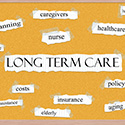Contributed by: Sandra Adams, CFP®
Many family members are drawn into caregiving out of love. Most times, it is the female child that is pulled into the role of caregiver as a parent ages and has increasing needs. The statistics are overwhelming…
66 million people in the U.S. provide unpaid care to a relative or friend.*
70% of caregivers report making adjustments to work schedules, or quit work altogether, to accommodate caregiving responsibilities. Caregivers may reduce their hours at work or forfeit promotions and benefits.**
A 2011 study showed that caregivers lost $303,880 in wages, Social Security benefits, and private pensions over their lifetime as a result of caregiving responsibilities.**
It is important to understand that caregiving and care needs can have serious consequences for the entire family, and that careful planning is important to ensure financial stability for all parties involved.
When to Officially Hire a Family Member
In many cases, skilled care is needed, and that care needs to be provided by trained and licensed medical professionals. However, there are other needs (i.e. transportation, housekeeping, etc.) that can be provided by a family member. In these cases, you can consider officially hiring a family member under a paid family caregiver contract. A family caregiver contract is a legal employment contract that defines the care and compensation expectations between the aging parent and the family member providing the care. Here are three reasons for a family to consider using a family caregiver contract:
The family member providing the care (the caregiver) can be receiving financial compensation for providing care, especially when they may have had to reduce or give up entirely their paid employment. The caregiver is provided a chance for continued financial stability.
It can help avoid misunderstandings and bad feelings with other family members about who is providing care and how much money is changing hands. The agreement can be very specific and can be tied to the aging parent’s overall estate planning.
If the aging parent ever needs to enter a nursing home or needs Medicaid to pay for long term care needs, the agreement can show that payments for the care to the family member were legitimate and were not made in an attempt to “hide” or “gift” funds in order to qualify for Medicaid.
When it comes to planning for aging parents and coordinating the caregiving roles amongst family members, things can get complicated very quickly. It often comes down to the one who is nearest, not who has the time or the money, that becomes the caregiver. Making things fair and giving your parent and the sibling(s) who provide care the best chance for financial stability along the way is the best course of action. Work with your financial planner and a team of experts to come up with a plan for your family that may include an elder law attorney to consider tools like a family caregiver contract.
Sandra Adams, CFP® is a Partner and Financial Planner at Center for Financial Planning, Inc. Sandy specializes in Elder Care Financial Planning and is a frequent speaker on related topics. In 2012-2014 Sandy has been named to the Five Star Wealth Managers list in Detroit Hour magazine. In addition to her frequent contributions to Money Centered, she is regularly quoted in national media publications such as The Wall Street Journal, Research Magazine and Journal of Financial Planning.
Five Star Award is based on advisor being credentialed as an investment advisory representative (IAR), a FINRA registered representative, a CPA or a licensed attorney, including education and professional designations, actively employed in the industry for five years, favorable regulatory and complaint history review, fulfillment of firm review based on internal firm standards, accepting new clients, one- and five-year client retention rates, non-institutional discretionary and/or non-discretionary client assets administered, number of client households served.
*National Alliance for Caregiving and AARP. Caregiving in the U.S., 2009.
**The MetLife Mature Market Institute, MetLife Study of Caregiving Costs to Working Caregivers, June 2011.
The information has been obtained from sources considered to be reliable, but we do not guarantee that the foregoing material is accurate or complete. Any opinions are those of Sandra Adams and not necessarily those of Raymond James. Raymond James and its advisors do not offer tax or legal advice. You should discuss any tax or legal matters with the appropriate professional. Links are being provided for information purposes only. Raymond James is not affiliated with and does not endorse, authorize or sponsor any of the listed websites or their respective sponsors. Raymond James is not responsible for the content of any website or the collection or use of information regarding any website's users and/or members.




















